There is no substitute for seeing portrait miniatures first-hand. At only 5–6cm in diameter, the astonishingly small scale at which artists achieved such intricacy and psychological penetration is impossible to appreciate unless seen in person. The term ‘portrait miniatures’ was rarely used by the Elizabethans, who preferred the terms ‘limning’ or ‘pictures in little’. Yet, despite their small dimensions, miniatures have exerted powerful effects on their viewers, whether Elizabethan or contemporary. Period sources brim with anecdotes about the longing gazes and secret passions that miniatures encouraged. In his Autobiography, the courtier and philosopher Lord Edward Herbert of Cherbury recounts how, walking one day through Lady Ayres’ bedchamber, he discovered her lying on her bed, gazing at a miniature. When she tried to hide it from him, he insisted on seeing it, only to discover that ‘it was my Picture she looked upon with more earnestness and Passion than I could have easily believed’. The miniature was by Isaac Oliver (c. 1565–1617), the less well-known but equally brilliant pupil and competitor of the more famous Nicholas Hilliard (c. 1547–1619); Hilliard’s portraits elicited similarly intense responses. Their effects still make themselves felt centuries later: as Roy Strong, one of the miniature’s most prominent champions, has written, ‘these objects present the men and women of their age as they really were’.
The 400th anniversary of the death of Nicholas Hilliard is being marked in several ways. ‘Elizabethan Treasures: Miniatures by Hilliard and Oliver’, the first major exhibition of portrait miniatures in the UK for more than 30 years, has just opened at the National Portrait Gallery in London (until 19 May). Meanwhile, a new biography by Elizabeth Goldring presents fresh archival evidence about Hilliard’s turbulent life. Scholarly interest in Oliver is also growing and a joint project underway at the Fitzwilliam Museum and the Hamilton Kerr Institute for Conservation approaches his miniatures from a technical perspective. A display revealing some of the project’s findings can currently be found in the Fitzwilliam’s Rothschild Gallery (until 18 August).
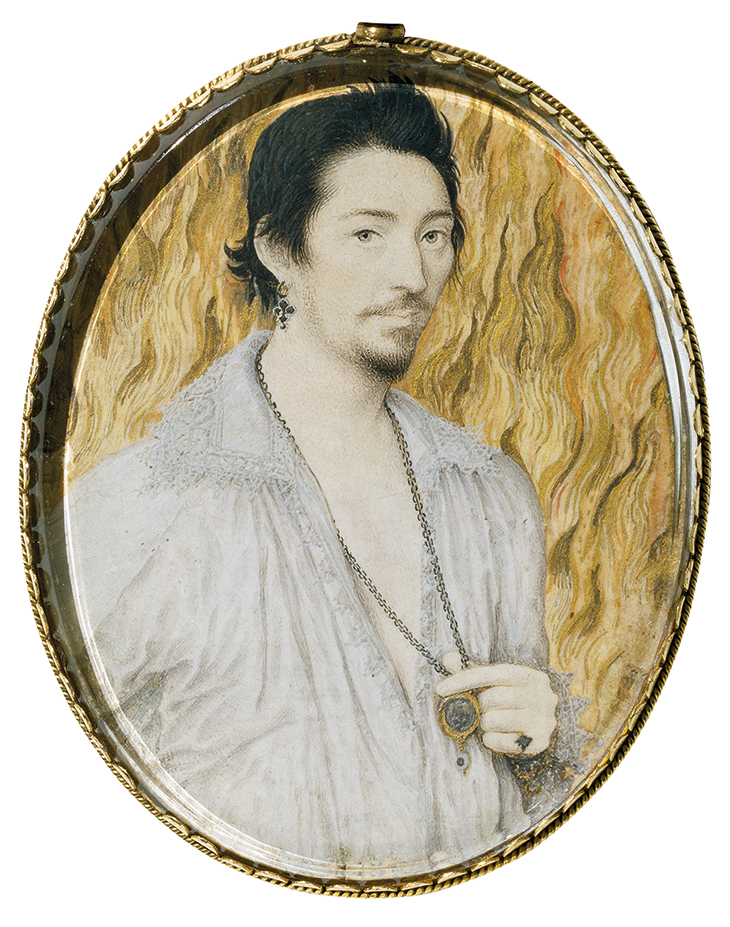
Unknown Young Man against a Background of Flames (c. 1600), Nicholas Hilliard. Victoria and Albert Museum, London
Herbert of Cherbury’s description of Lady Ayres’ response sounds like hyperbole, but such intensity is exactly what many miniatures were designed to elicit from their viewers. Two portraits of young men consumed by flames, one by Hilliard and the other by Oliver, demonstrate the miniature’s association with passion and courtship. Hilliard’s young man stands in front of the flames wearing only his undershirt, open to the waist. He holds a jewel or miniature case to his heart, perhaps containing the image of his lover, the intended recipient of this portrait. In Oliver’s version of the same theme, the fire completely engulfs the young man, whose message to his lover is conveyed by the motto Alget qui non ardet: ‘He grows cold who does not burn.’ Both artists have made extensive use of powdered gold, so that when the miniatures move, the flames seem to flicker.
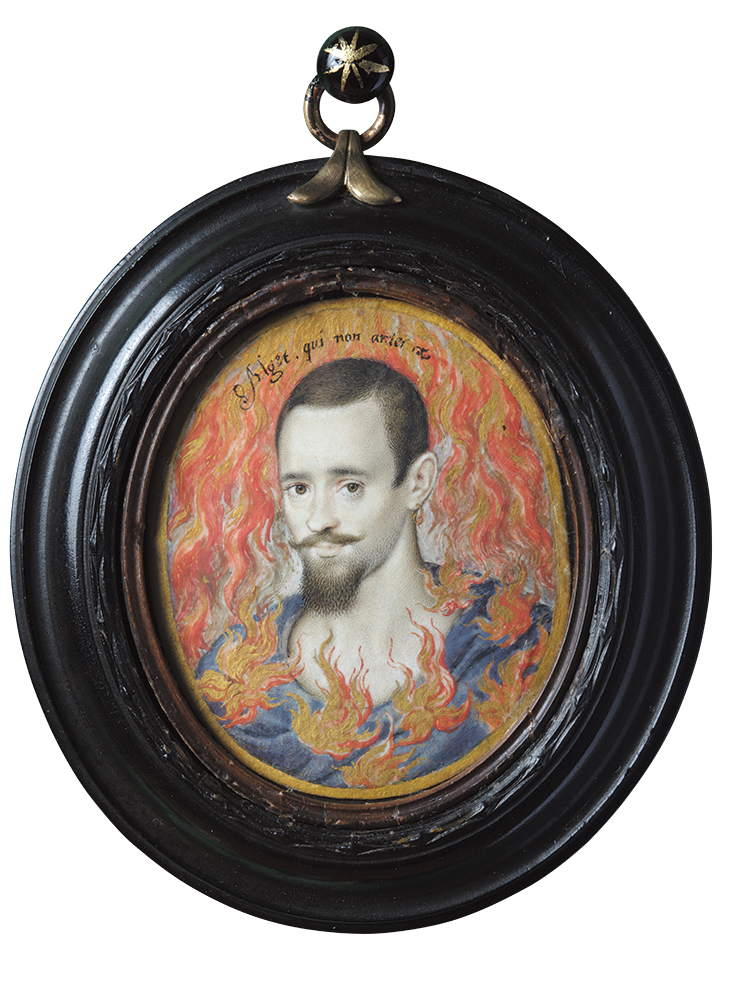
A Man Consumed by Flames (c. 1610), Isaac Oliver. Ham House, Surrey. Photo: © National Trust/Christopher Warleigh-Lack
Like Young Man Among Roses, perhaps the best known work in this genre, these two portraits exemplify the Elizabethan love of allegory and metaphor. Symbols and mottos abound in these images, and where the identity of the sitter has been lost, as it often has, the meaning can be difficult to recover. Yet even when miniatures keep their secrets, we can still appreciate what Strong means when he says these portraits show their sitters ‘as they really were’. Miniatures are perhaps ideally suited to the present age of smartphones and tablets. We are used to seeing images at close range, held in our own hands, ‘encased’ in the precious materials of the latest iPhone. Although flaming selfies are rare, we can pepper our photos with hearts and kisses, which amounts almost to the same thing. Although our present circumstances may be suited to enjoying and understanding the portrait miniature, the two most brilliant artists of the genre are not equally well appreciated.
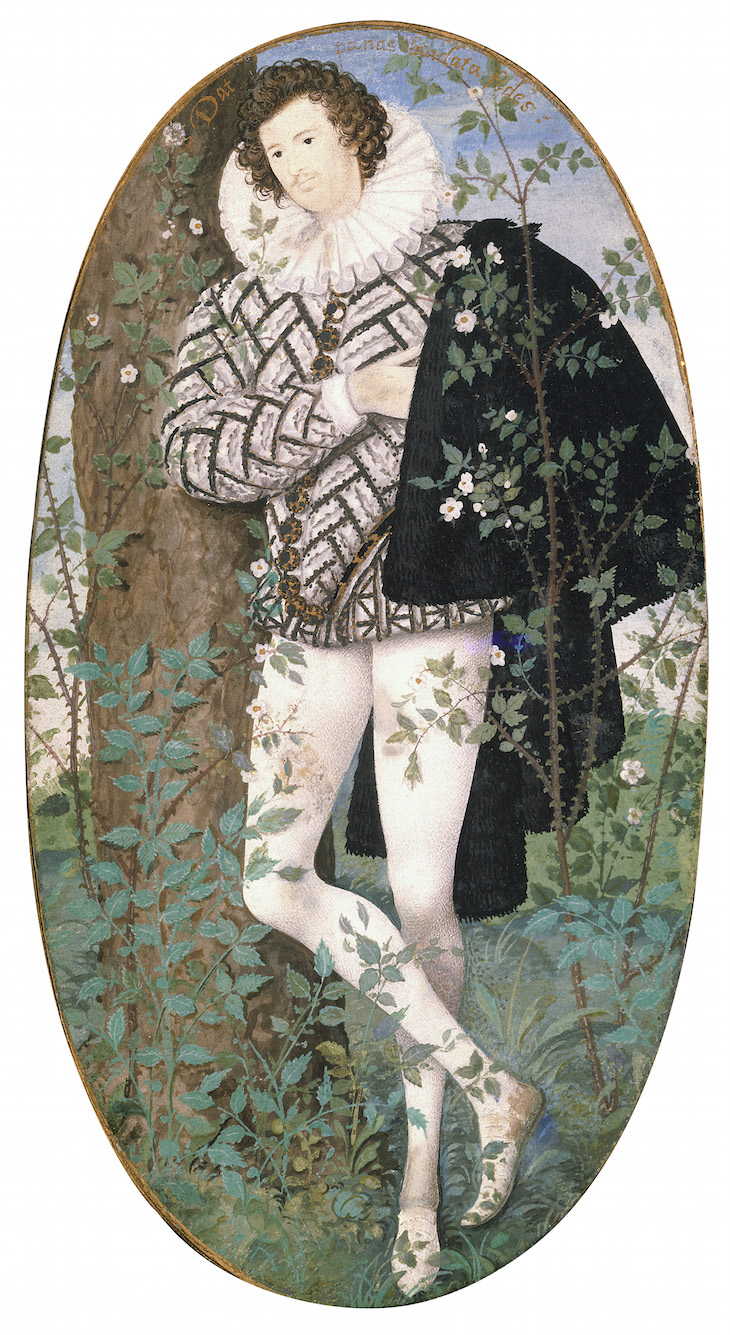
Young Man among Roses (1585–95), Nicholas Hilliard. Victoria and Albert Museum, London
Hilliard’s portraits help to define our cultural memory of Elizabeth I in much the same way that Hans Holbein’s portraits define that of Henry VIII. In addition, the details of his life can be traced in a variety of documentary sources, and his manuscript A Treatise Concerning the Arte of Limning (c. 1600), part defence of the craft, part how-to guide, is a rare example of an Elizabethan artist meditating on his practice. Oliver, however, has left few traces apart from his art. While Hilliard painted the great and the good of Elizabethan society from the first, Oliver began his career painting the middle classes, only later gaining access to the aristocracy. He never managed to impress Elizabeth I, although he was favoured by Anne of Denmark, wife of James I, and their son Henry, Prince of Wales.
Oliver’s work has barely penetrated beyond art-historical and connoisseurial circles, where he is often considered superior to Hilliard. His use of linear perspective and modelling is seen as heralding later developments in English art. This fact has sometimes been used to give Oliver’s stylistic choices an almost evolutionary superiority – his was the fruitful path, his son Peter becoming a successful miniaturist in his own right – while Hilliard is consigned to one of history’s ‘dead ends’, medievalism’s last gasp in England. Yet for the Elizabethans Hilliard was unsurpassed. Exactly why these two artists have experienced such different critical fortunes is worth exploring, not least because it reveals a great deal about how the appreciation of art can be influenced by, and influence in turn, narratives about nationality and cross-cultural contact.
English artists of the 16th and early 17th centuries have often been compared unfavourably with their counterparts on the continent. In Italy and much of Europe the Renaissance was well established, with developments such as linear perspective, the study of anatomy and naturalistic modelling gaining popularity among artists. The peculiar nature of the English Reformation and a latent island mentality are seen as having isolated England from these advances. Meanwhile, any innovations which did take place are associated with immigrant artists such as Hans Holbein. In the last few decades there have been serious attempts to approach English art on its own terms, rather than as the poor cousin of the continental Renaissance. In the traditional narrative, however, Oliver is celebrated because he injects English art with a degree of sophistication only otherwise seen, it is claimed, on the continent.
It is undeniable that Oliver, unlike Hilliard, was in touch with continental developments. The child of French Huguenot refugees, Oliver maintained his artistic contacts in the immigrant community throughout his life – he married Sara, sister of another successful artist, Marcus Gheeraerts II – and travelled to Italy. Hilliard also went abroad: as a child he lived in Germany and Geneva for four and a half years, in the household of John Bodley (father of Thomas, founder of the Bodleian Library in Oxford), who was fleeing the Catholic reign of Mary I. As an adult Hilliard also spent two years at the French court in the employment of François, Duke of Anjou. Although Elizabeth Goldring has suggested that Hilliard’s travels may have brought him into contact with the work of artists such as Albrecht Dürer, whom he praised in his Treatise, his art was less strongly influenced by continental ideas than Oliver’s.
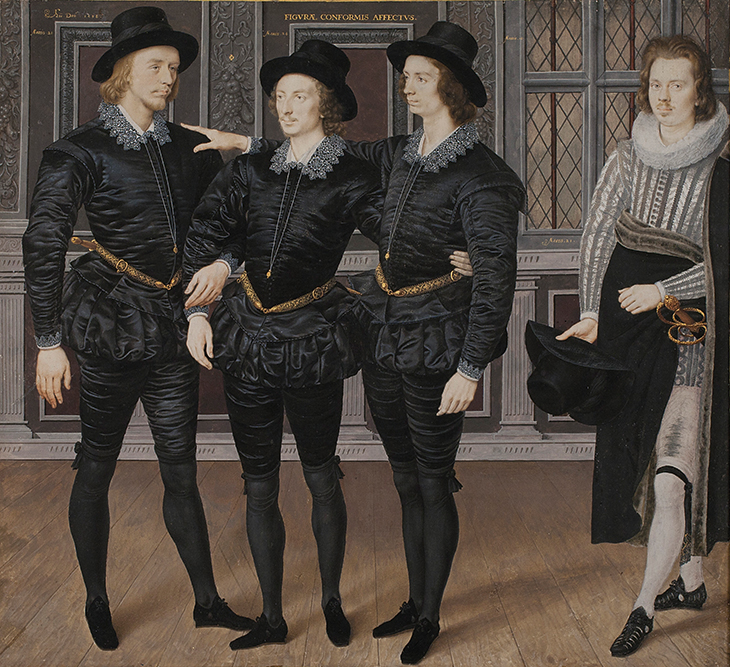
The Three Brothers Browne (1598), Isaac Oliver. Burghley House, Stamford, Lincolnshire
Hilliard and Oliver are worlds apart in their use of techniques like perspective. Take, for example, two ‘cabinet miniatures’ (generally larger than normal miniatures, and rectangular): Henry Percy, 9th Earl of Northumberland by Hilliard and The Three Brothers Browne by Oliver. While Oliver’s handling of the recessing floorboards under the brothers’ feet is more or less convincing, Hilliard’s attempt at perspective makes the garden ledge on which Northumberland reclines seem steeply tilted; the earl looks as if he is in danger of rolling off. This is an extreme example, but it suggests that, while Oliver was aware of and interested in developments from the continent, Hilliard either would not or, more probably, could not adopt them.
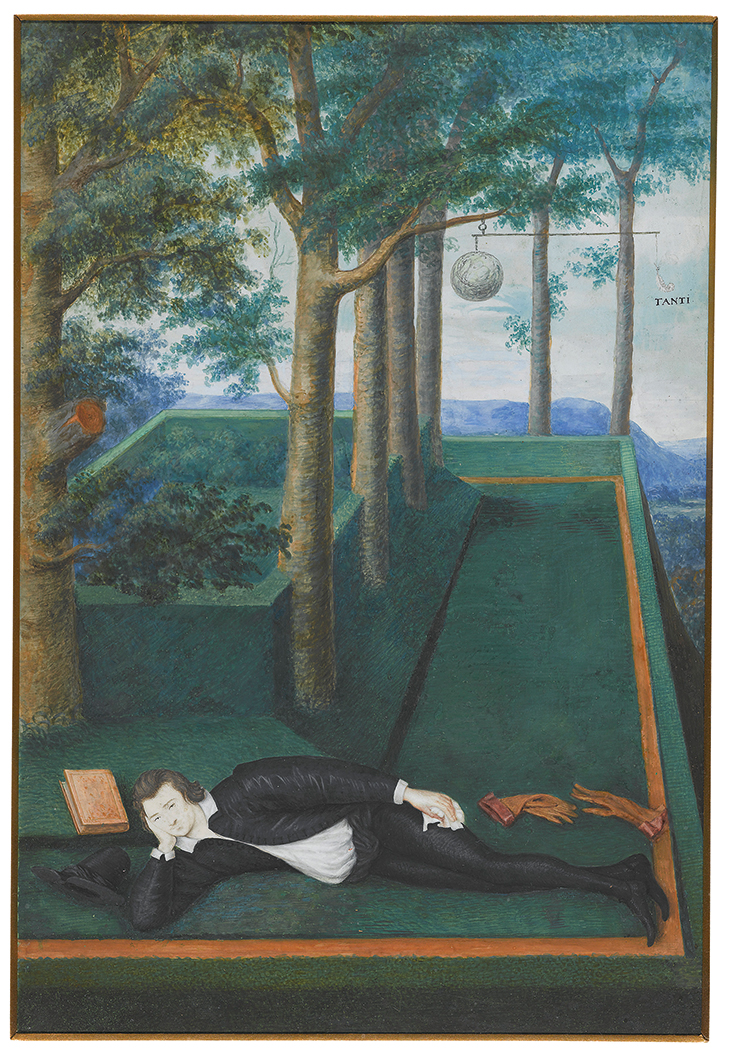
Henry Percy, 9th Earl of Northumberland (c. 1590–93), Nicholas Hilliard. Rijksmuseum, Amsterdam
The same goes for the use of chiaroscuro or shading in miniatures. Hilliard in his Treatise advocates for ‘plaine lines without shadowing’ in miniatures which are ‘to be viewed of necessity in hand near unto the eye’. Admittedly, his work was not originally as linear as this comment might suggest: recent technical analysis by Katherine Coombs and Alan Derbyshire shows that Hilliard used ‘fugitive’ pigments, which we now know lose their colour over time. This has left his shaded areas disproportionately faded in relation to the rest, making many of his miniatures appear flatter and more washed-out than they were originally. Nevertheless, even a comparison of relatively well-preserved miniatures, such as Hilliard’s Francis Bacon with Oliver’s own self-portrait, shows that Oliver made much greater use of directional light, leaving some of his face in shadow, whereas Hilliard allows no shadow to fall across Bacon’s features.
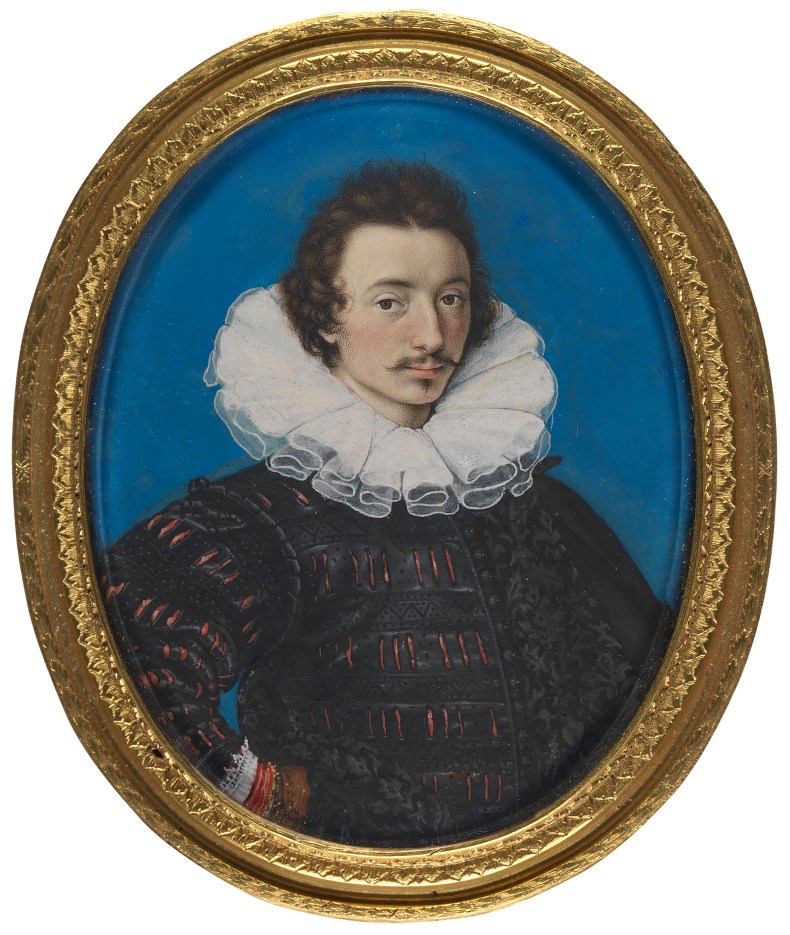
Self-Portrait (c. 1590), Isaac Oliver. National Portrait Gallery, London
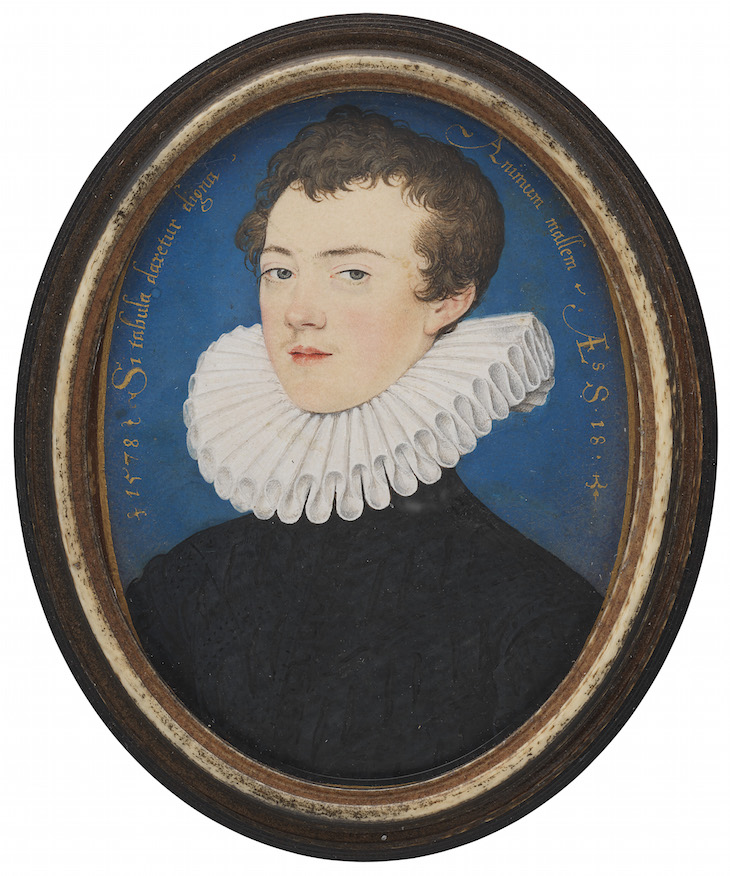
Francis Bacon, later Baron Verulam and Viscount St Alban (1578), Nicholas Hilliard. National Portrait Gallery, London
But while art historians today may associate Oliver with brilliant continental innovations, it was Hilliard who inspired the greatest rapture in Elizabethan poets. In ‘The Storm’, John Donne, whose Hilliard-esque portrait was actually painted by Oliver, wrote: ‘a hand, or eye / By Hilliard drawn, is worth a history / By a worse painter made.’ Elsewhere, Hilliard is directly compared with his Italian contemporaries: John Harington’s translation of Ariosto’s Orlando Furioso glosses the poem’s references to Italian artists, adding: ‘we have with us at this day one that for limning (which I take to be the very perfection of that art) is comparable with that of any other country […] for taking the true lines of the face, I think our countryman (I mean M. Hilliard) is inferior to none that lives at this day.’ Similarly, Richard Haydocke, translator of Lomazzo’s Italian art treatise, states that ‘Nicholas Hilliard’s hand, so much admired amongst strangers [could] strive for a comparison with the mild spirit of the late world’s-wonder Raphael Urbine; for […] his perfection in ingenious Illuminating or Limning, the perfection of Painting, is […] so extraordinary.’ Hilliard’s English origins enabled his work to be held up as an example of English artistic prowess, while his chosen genre fed into other ideas about English identity that shaped Elizabeth’s court.
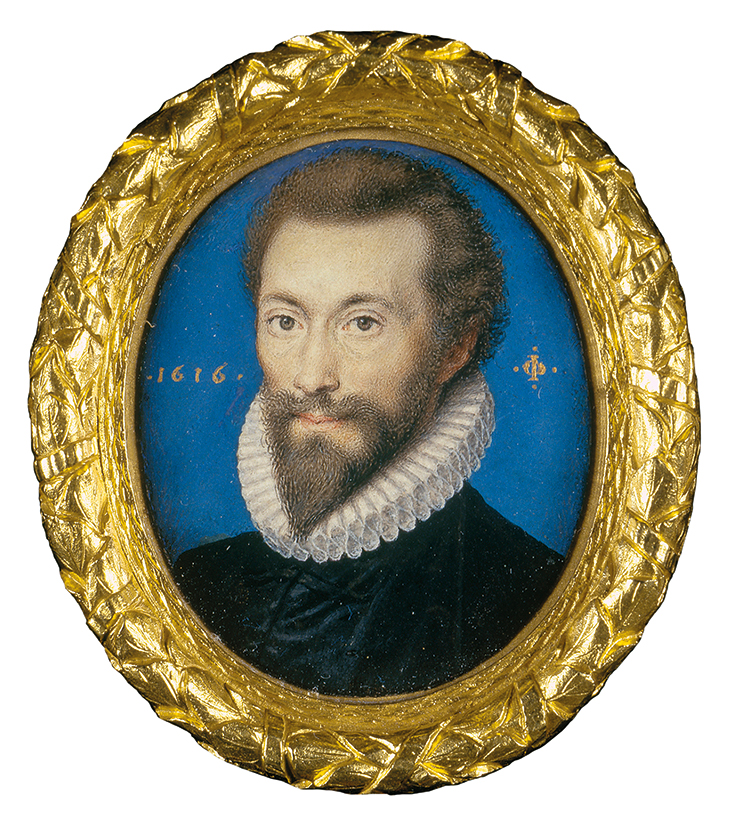
John Donne (1616), Isaac Oliver. Royal Collection Trust, London
In Elizabethan England, innovations such as chiaroscuro and linear perspective were almost entirely alien, and even a little suspect, due to their associations with Catholic Europe. The desire to keep up with foreign rulers such as the Medicis was counterbalanced by an interest in England’s own cultural heritage. Indeed, the revival of portrait miniatures at the Elizabethan court was part of a wider ‘neo-medieval’ or neo-chivalric movement. Miniature painting or ‘limning’ was a watercolour technique that grew out of manuscript illumination. Pigments were mixed with water and gum arabic, the hardened sap of the acacia tree, to make translucent watercolour and, with the addition of more pigment, opaque ‘bodycolour’ paint. The term ‘portrait miniature’, not much used at the time, derives from miniare, Italian for ‘to illuminate’, and from Latin minium, red lead – not, as one might expect, from Latin words associated with smallness, such as minimum. The more popular word ‘limning’ derived from Latin luminare and shared the association with manuscript illumination. Limning’s medieval resonances fitted perfectly with the revival of chivalric ‘courtly love’ and the neo-medieval atmosphere of the Elizabethan jousts. Participants, like George Clifford, 3rd Earl of Cumberland, often chose to have themselves recorded in cabinet miniatures, wearing full tilting armour.
For Elizabethans, the miniature’s power and perfection depended on qualities other than naturalistic lighting effects and convincing perspective. One of the most important was how directly the portrait corresponded to reality. The poet Henry Constable, writing of a portrait of Lady Rich, praised Hilliard’s ability ‘To give to stones and pearls true die and light’. Hilliard was famed for his attention to costume and jewellery, and used paint made from powdered gold and silver, explaining in his Treatise that limning ‘works the metals Gold or Silver with themselves which so enriches and ennobles the work that it seems to be the thing it self even the work of God and not of man’. The literalism that this use of gold and silver represents seems to have appealed to Elizabethan patrons, and Hilliard also developed new methods for representing precious stones. After laying a spot of gold or silver, he would use a hot needle to place a drop of coloured resin on top, imitating the translucent, three-dimensional qualities of real rubies and emeralds. He also used silver to give highlights to pearls, and although these have now often oxidised to black, the effect would have been dazzling at the time.
Above all else, it was limning’s ability to capture a likeness directly and vividly that made it ‘the perfection of art’ for so many Elizabethans. This derived partly from the way in which a miniature was made. Unlike large-scale oil paintings, which were often painted over the course of several months from preparatory sketches or face-patterns, limnings were made almost entirely in the presence of the sitter. In his Treatise, Hilliard suggests ways to make the sitting as enjoyable and comfortable as possible: ‘sweet odours comfort the brain and open the understanding, augmenting the delight in limning, discreet talk or reading, quiet mirth or music offend not, but shorten the time, and quicken the spirit both in the drawer, and he which is drawn’. Hilliard does not explicitly say how many sittings were needed, but the later miniaturist Edward Norgate, who knew Hilliard’s methods, recommends three sittings of several hours each, with jewels and costumes finished in between, in the artist’s own time. The presence of the sitter was vital to the finished miniature’s vividness, because it allowed the artist to ‘catch those lovely graces, witty smilings, and those stolen glances which suddenly like lightning pass and another Countenance takes place’, as Hilliard writes in the Treatise. He stresses the speed at which the artist had to work, to ‘catch’ an expression which passed ‘like lightning’, demonstrating the immediate transfer of the person’s appearance to vellum, carrying with it the power of their presence.
Not unlike the images of saints cherished by Catholics, miniatures were kissed, worn on the person, and mounted in precious and bejewelled cases. Flaunted in public, pored over in private, the miniature’s ability to convey the sitter’s presence made them ideally suited to diplomatic exchanges and other intimate negotiations, such as courtship. Miniatures were a way to persuade a lover of one’s affection, to assure a friend of one’s support, to incite loyalty to the monarch. Four hundred years later, portrait miniatures are not just elaborate costume pieces, but vivid, intimate portrayals of individual Elizabethans as they wanted to be seen, in love or in mourning, royal or beautifully ordinary.
‘Elizabeth Treasures: Miniatures by Hilliard and Oliver’ is at the National Portrait Gallery, London, until 19 May.
From the March 2019 issue of Apollo. Preview the current issue and subscribe here.
Unlimited access from just $16 every 3 months
Subscribe to get unlimited and exclusive access to the top art stories, interviews and exhibition reviews.

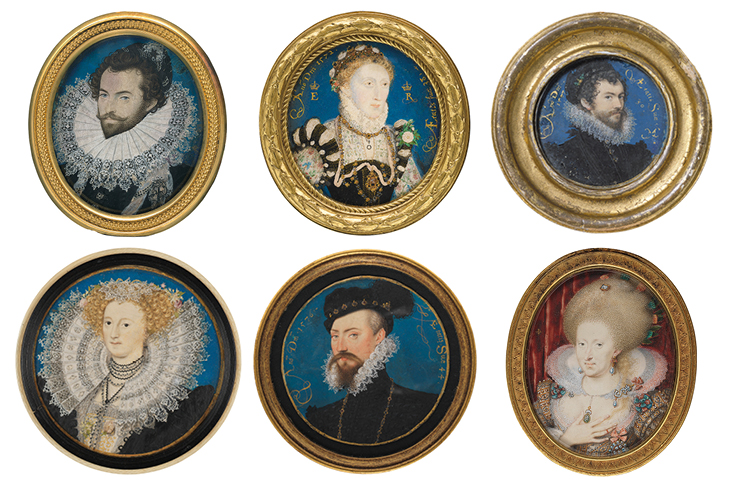
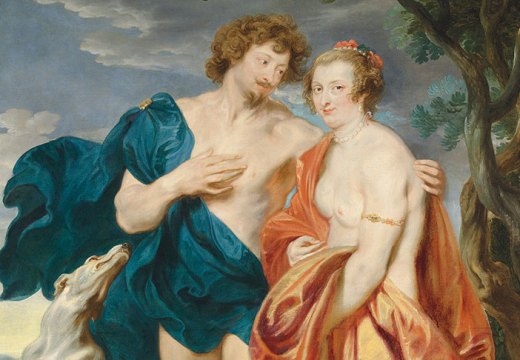
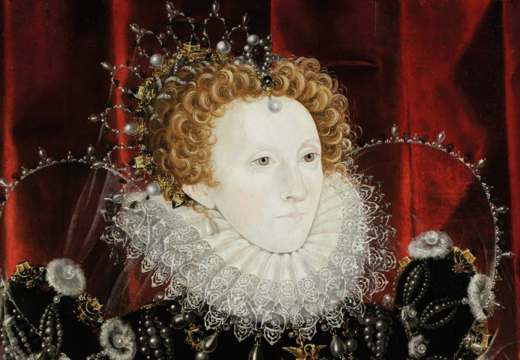
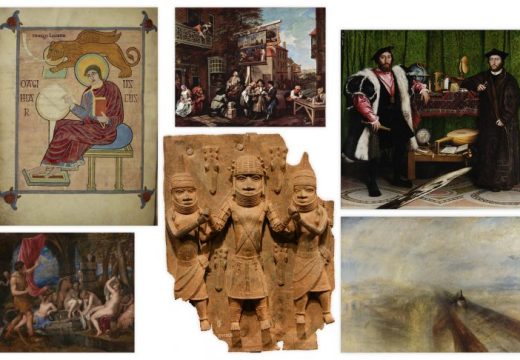









![Masterpiece [Re]discovery 2022. Photo: Ben Fisher Photography, courtesy of Masterpiece London](http://www.apollo-magazine.com/wp-content/uploads/2022/07/MPL2022_4263.jpg)
Has the Fitzwilliam lost the hang of things?